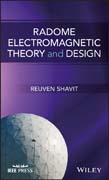
Radome Electromagnetic Theory and Design explores the theoretical tools and methods required to design radomes that are fully transparent to the electromagnetic energy transmitted or received by the enclosed antenna. A radome is a weatherproof and camouflaged enclosure that protects the enclosed radar or communication antenna, and are typically used on a fixed or moving platform such as an aircraft, ship or missile. The author a noted expert in the field examines the theoretical methods that apply to all type of radomes: planar, conformal, airborne and ground based. The text offers a description of the various measurement methods that characterise the electrical parameters of a radome, and discusses their merits in terms of accuracy. This groundbreaking book brings together in one volume all the necessary theoretical tools to design radomes INDICE: Preface xi .Acknowledgments xiii .1 Introduction 1 .1.1 History of Radome Development 4 .1.2 Types of Radomes 6 .1.2.1 Solid Laminate 6 .1.2.2 Inflatable 7 .1.2.3 Sandwich 8 .1.2.4 Metal Space Frame 8 .1.2.5 Dielectric Space Frame 10 .1.3 Organization of the Book 10 .References 12 .2 Sandwich Radomes 15 .2.1 Transmission Line Analogy 16 .2.2 Multilayer Analysis 17 .2.3 Single Layer 22 .2.4 A–Sandwich 28 .2.5 B–Sandwich 31 .2.6 C–Sandwich 33 .References 37 .Problems 37 .3 Frequency Selective Surfaces (FSS) Radomes 39 .3.1 Scattering Analysis of Planar FSS 40 .3.2 Scattering Analysis of Multilayer FSS Structures 62 .3.3 Metamaterial Radomes 72 .References 86 .Problems 87 .4 Airborne Radomes 89 .4.1 PlaneWave Spectrum Combined with Surface Integration Technique 91 .4.1.1 Multilevel Algorithm for Radiation Pattern Computation 103 .4.2 Surface Integration Technique Based on Equivalence Principle 109 .4.3 Volume Integration Formulation Methods 123 .4.3.1 Solution Using Fast Multipole Method 126 .4.4 Differential Equation Formulation Methods 132 .References 138 .Problems 141 .5 Scattering fromInfinite Cylinders 145 .5.1 Heterogeneous Beams Volume Integral Equation Formulation 147 .5.2 Homogeneous Beams Surface Integral Equation Formulation 160 .5.3 Conductive Beams Surface Integral Equation Formulation 166 .5.4 Tuned Beams Surface Integral Equation Formulation 176 .5.5 Scattering from Infinite Cylinders Differential Equation Formulation 185 .References 194 .Problems 195 .6 Ground–BasedRadomes 201 .6.1 Scattering from an Individual Beam 203 .6.2 Scattering Analysis of the Beams Assembly 206 .6.2.1 Transmission Loss 211 .6.2.2 Sidelobe Level Increment 211 .6.2.3 Null Depth Increment 212 .6.2.4 Beamwidth Change 212 .6.2.5 Boresight Error 212 .6.2.6 Boresight–Error Slope 213 .6.2.7 Cross–Polarization Ratio 213 .6.2.8 Antenna Noise Temperature 213 .6.3 Geometry Optimization 215 .6.4 Intermodulation Distortion in MSF Radomes 217 .6.4.1 The IMP Effect in MSF Radomes 218 .References 220 .Problems 222 .7 MeasurementMethods 225 .7.1 Panel Measurements 226 .7.2 Characterization of Forward–Scattering Parameters 227 .7.2.1 Far–Field Probing 228 .7.2.2 Near–Field Probing 234 .7.2.3 Focused–Beam System 240 .References 252 .Problems 254 .Appendices 255 .A Vector Analysis 255 .A.1 Coordinate Transformations 255 .A.1.1 Azimuth over Elevation Positioner 256 .A.1.2 Elevation over Azimuth Positioner 257 .A.2 Vector Differential Operators 258 .B Dielectric Constants and Loss Tangent for Some Radome Materials 261 .C Basic Antenna Theory 263 .C.1 Vector Potentials 263 .C.2 Far–Field Approximation 267 .C.3 Directivity and Gain 269 .C.4 Antenna Noise Temperature 269 .C.5 Basic ArrayTheory 270 .D Conjugate Gradient Algorithm 273 .References 274 .Index 275
- ISBN: 978-1-119-41079-9
- Editorial: Wiley–Blackwell
- Encuadernacion: Cartoné
- Páginas: 328
- Fecha Publicación: 27/04/2018
- Nº Volúmenes: 1
- Idioma: Inglés
